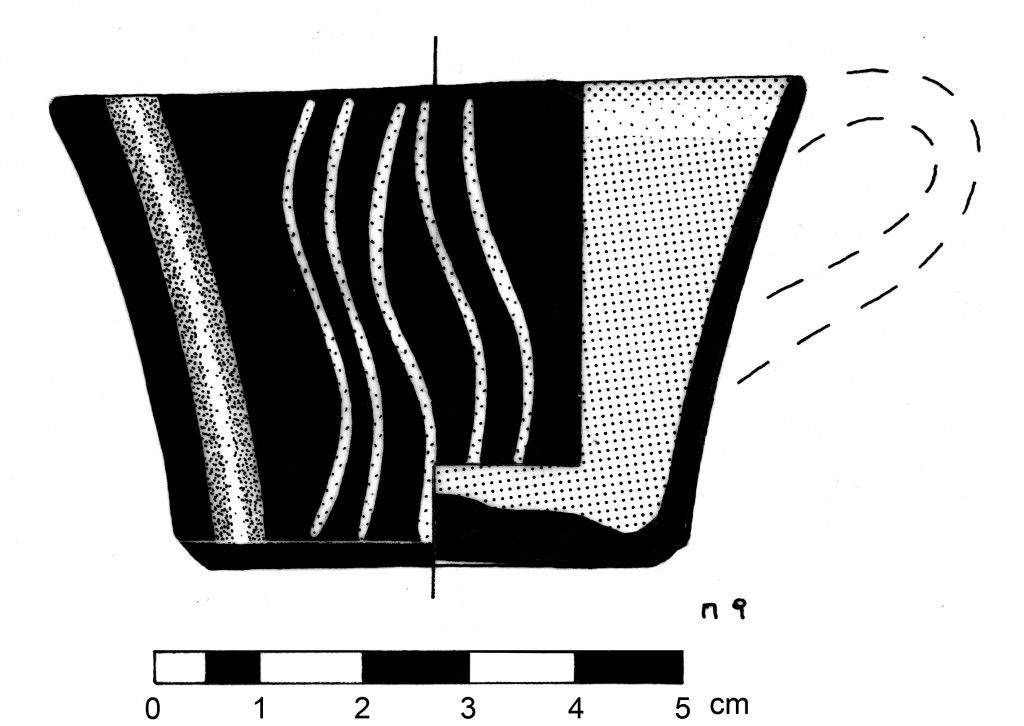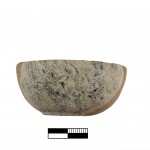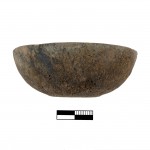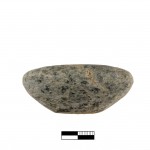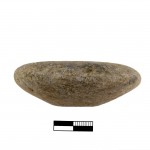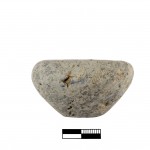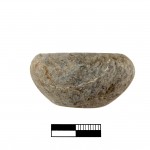Citation with persistent identifier:
Flouda, Georgia. “Minoan Communities and Commemorative Practices: The Late Prepalatial to Protopalatial Tholos Tomb A at Apesokari/Crete.” CHS Research Bulletin 3, no. 1 (2014). http://nrs.harvard.edu/urn-3:hlnc.essay:FloudaG.Minoan_Communities_and_Commemorative_Practices.2014
http://www.youtube.com/watch?v=sznDeYtT99Q
1§1 Charged with emotional content, the burial of the deceased is cross-culturally one of the social events that create the most powerful associations. Ancestor commemoration goes one step further, as it involves practices relating to the formation and maintenance of shared memories of the apical ancestors, namely the common ancestors from whom kin groups trace their descent (McAnany 2000; Tomlinson 2009). In south-central Crete burial in the communal stone-built tholos tombs was practiced from the early Prepalatial to the end of the Protopalatial period, namely for a period of about 14 centuries (ca. 3100-1700 BC,[1] Early Minoan I–Middle Minoan II ceramic phases[2]).[3] Spread across the fertile Mesara valley and the marginal zone of the Asterousia mountains,[4] these above-ground circular vaulted monuments were built according to a standardized architectural form, which obviously conformed to the metaphysical beliefs of the society (Murphy 2003, Chapter 6). The clustering of usually two or even three tholos tombs near each possible settlement locus implies that one of the key factors in their creation was accentuating the different groups within each community and projecting their claims to natural resources (Murphy 2011; Legarra Herrero 2012).[5]
1§2 This presentation focuses on the commemorative practices performed inside and outside Tholos Tomb A at Apesokari (Figs.1-2) which was built in the Early Minoan III (2200-2100 BC), when the communal forms of organization became subordinate to the interests of emerging elite households (Tomkins and Schoep 2010, 76). At this point, the new paved or enclosed open-air areas outside the tholos tombs served as focal points for the commemoration of dead community members by larger numbers of people (Branigan 1998, 19-23), and were possibly exploited “to define differential identity” (Tomkins and Schoep 2010, 76). In the case of Tholos Tomb A at Apesokari, its looting prior to the excavation by the Austrian archaeologist August Schörgendorfer in 1942 and the lack of an excavation notebook present great challenges for understanding the depositional contexts (Flouda 2011, 111-112). Nevertheless, the reconstruction departs from my working hypothesis that the social unit using the tomb can possibly be correlated with one of the kin groups of the community inhabiting the rocky Vigla hill[6] to the south, where dispersed habitatonal foci can be envisaged. This is supported by the unpublished remains of the associated multiphase habitation site excavated by Schörgendorfer on the south slope of Vigla hill.[7] A sequence of seven basement rooms served as the substructure for the first-floor of a freestanding two-story building (Schörgendorfer 1951b, pl.27), which was inhabited continuously until at least the late Neopalatial period. The artifactual deposits and the storage capacity of the building seem to correspond to a “household unit”, most probably equivalent to a clan or an extended family. The prominent location of the habitation site at the crossroads ensured control of the surrounding pastures and of the alluvial fields to the north, as well as of one branch of the access route leading from the important inland sites of Gortyn and Platanos to seaside Lebena on the south coast.
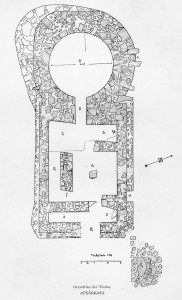
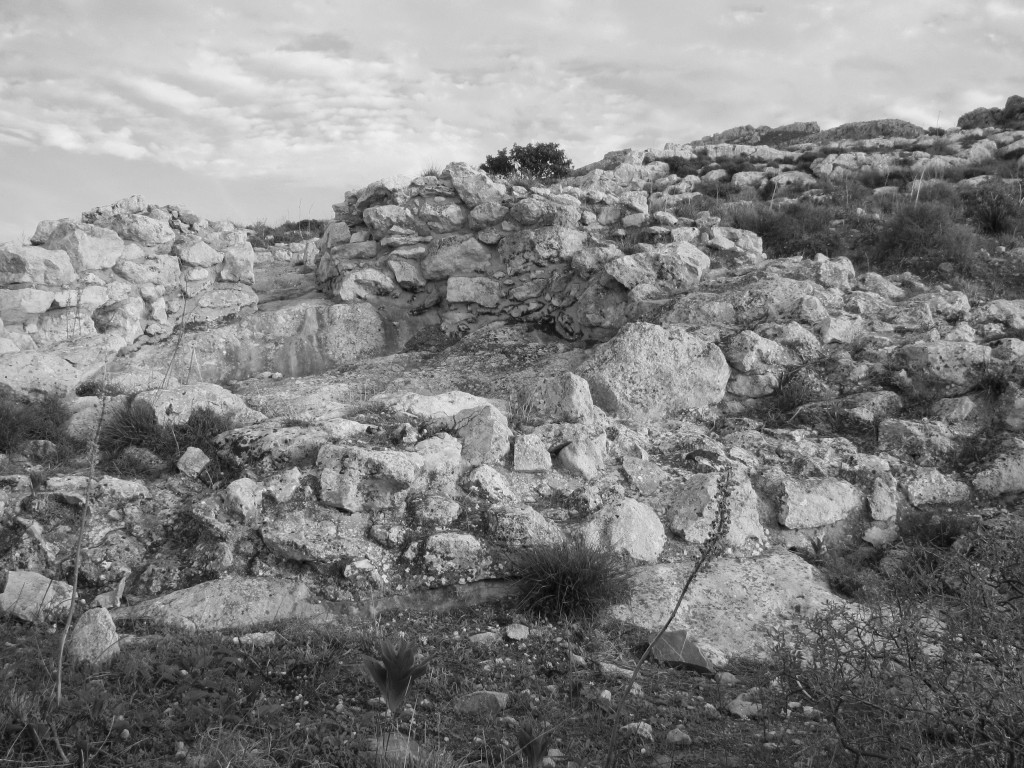
1§3 Tholos Tomb A is located on a hillside ca.130 meters away from the north slope of the settlement hill, with its entrance pointing to the southeast and away from the latter.[8] The fact that it was most possibly visible to and from the earlier Tholos Tomb B (Early Minoan I – Middle Minoan II) situated 220 metres to the east (Davaras 1964, 441; Vavouranakis 2012, 144-153; Vavouranakis, forthcoming), implies that they could be perceived as a single cemetery. I have elsewhere suggested that the symbolic potential of Tholos A as a local landmark was reinforced by the uniform plan of a rectangular annex compartment (Figs.1, 3) soon after the construction of the vaulted burial chamber (Flouda 2011, 112). Following earlier prototypes in the wider area, this annex was added soon after the construction of the burial chamber (EM III/MMIA terminus ad quem[9]) as an integral extension to the latter in order to be used for the secondary treatment of the burials and for rituals (Flouda 2011, 113).[10] The central stone-built pier at the center of the main annex room G (Fig.4) and the wide partition wall between rooms E and G indicate that the annex carried a permanent flat roof and, thus, stood out from a distance. Moreover, an open-air paved area to the east of the burial complex was also used continuously until at least the end of the Protopalatial period. Drawing upon this architectural setting, the landscape and the contextual associations of the burial assemblage, I will now venture to analyze patterns of the local mortuary behavior.
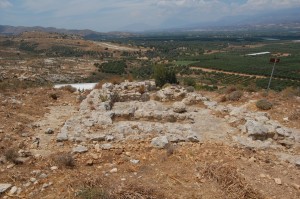
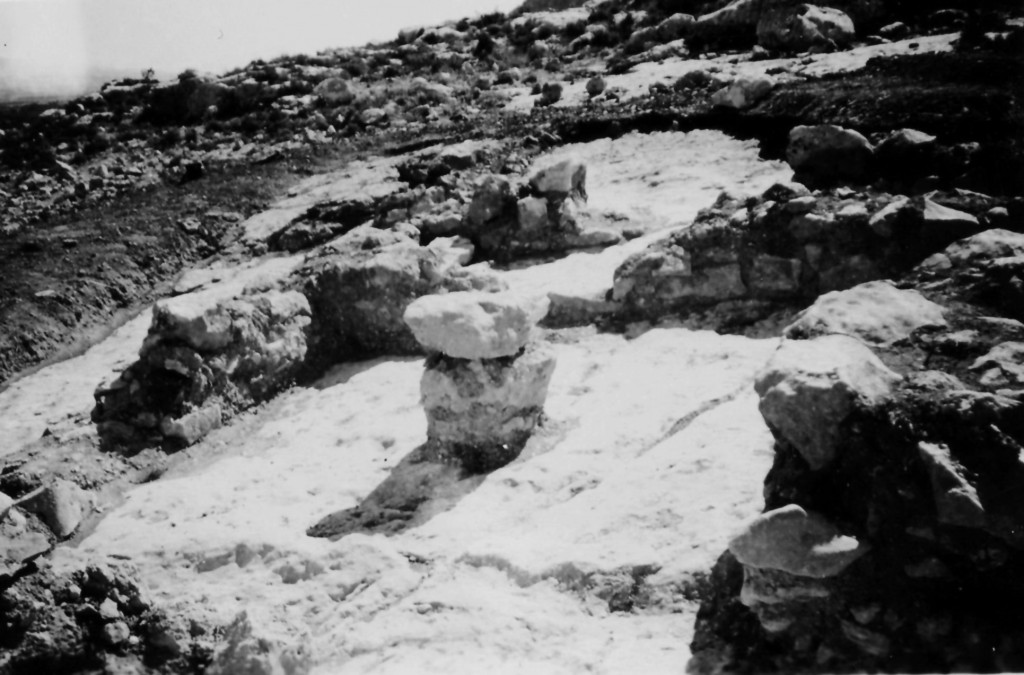
Mortuary and commemorative practices: from assemblages to the reconstruction of sequences of activities
2§1 The movement paths from Vigla hill to Tholos tomb A were obviously prescribed by the natural terraces of protruding limestone formations surrounding the former. Walking through these paths in different seasonal conditions every time a burial deposition or a commemoration event occured was part of the ritual practice. The burial procession from Vigla hill to Tholos A was probably given meaning by the continuous visual contact with the large entrance of the sacred Kamares cave, which was the focus of a community cult mainly during the Prepalatial and Protopalatial phases (Dawkins and Laistner 1912, 12-13; van de Moortel 2011, 316-317). The contextual associations of the burial assemblage support the concept of multi-staged mortuary rituals introduced through Arnold Van Gennep’s (1960, 1-15) notion that rites of passage relating to the transformation of identities universally involve a pre-liminal, a liminal and a post-liminal stage (Fowler 2013, 515). These correspond to three major psychological phases, namely separation, transition, and incorporation (Branigan 1993, 120). Separation is the most prominent one during the funeral ceremonies (Kimball 1960, vii-viii). The pre-liminal stage rites, like the washing and the clothing of the corpse for the funeral and its movement from the house to the tomb amidst lament, generally leave little if any material traces. In Tholos Tomb A, this stage is represented mostly by the habit of primary inhumation directly on the floor of the burial chamber (Schörgendorfer 1951a, 15), although there is also evidence for the use of burial containers[11].[12] No separate episodes of funerary events can be established due to the sequential nature of the “countless” primary interments and to post mortem interference.[13] These factors and the looting of the tomb have disrupted the primary depositions and their accompanying burial gifts,[14] thus making it hard to deduce how the identity of the deceased was represented through the burial. With regard to the sensorial aspects of the pre-liminal stage rites, the practice of fumigation is not documented here, but two clay lamps were used for illumination in the dark burial chamber. Two stone miniature vessels probably dating from the earliest phase of the tholos (EM III-MM I) hint at the use of ointment, perfumed oil or some kind of cosmetic pigment, used in the preparation of the corpse (Bevan 2004, 112; Bevan 2007, 98-99).[15] Ritualized liquid consumption or perhaps a practice of drinking toasts during the primary burial is also deduced from the deposition of small clay drinking and pouring vessels (Figs.5a-b) with the inhumations.[16] But no sharing between the participants is implied, as was the case during the earliest Prepalatial phases of the Moni Odigitria and Hagia Kyriaki cemeteries (Branigan 1993, 67). Overall, the finds from the burial chamber do not suggest that any differences in social status among the persons buried were projected, although prestige burial gifts may have been removed by the tomb looters. The burial chamber finally became inaccessible by the beginning of the 18th century BC at the latest (MM IIA phase), as suggested by a juglet, which possibly signals a drinking event at the time of the latest interment.
|
|
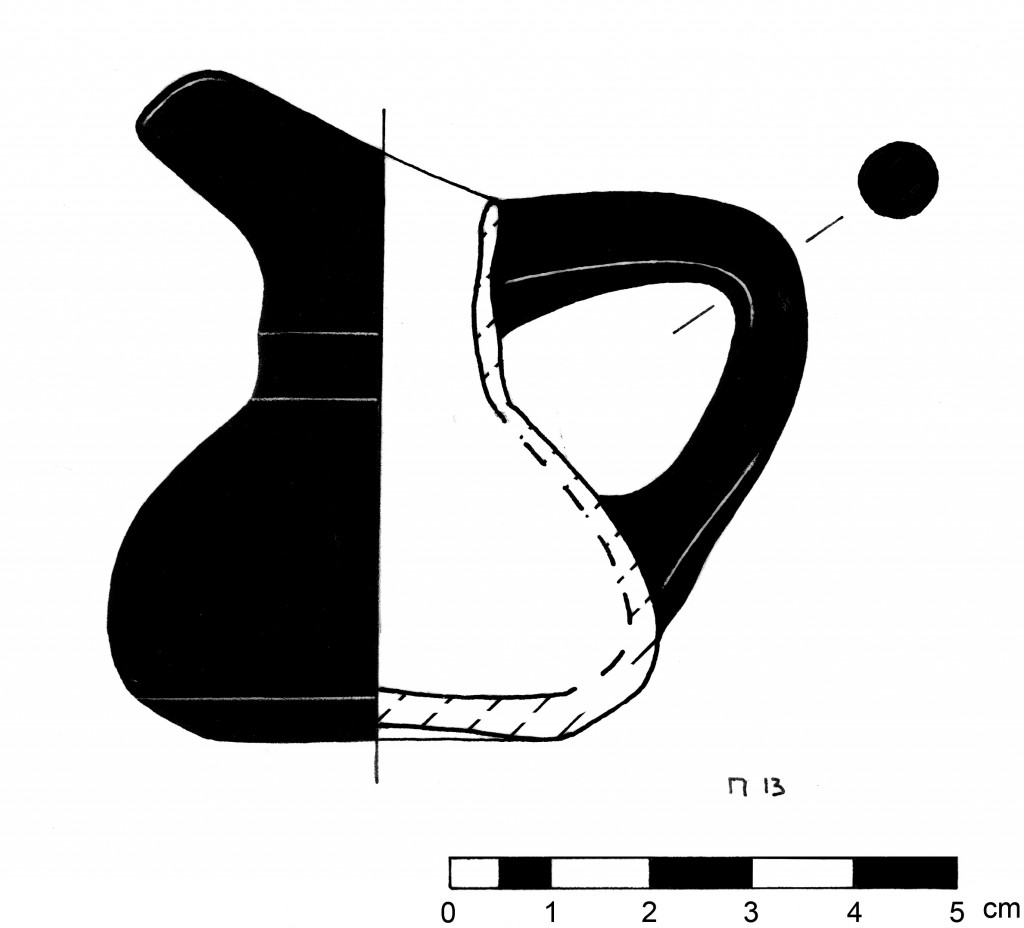 |
2§2 The post-liminal stage of the selection and removal of mainly skulls and long bones for secondary deposition[17] is confirmed in Tholos Tomb A through the patterns of representation of anatomical units in the available sample of human remains studied by Sevi Triantafyllou. The latter may come from the three extended burials excavated in rooms C and E of the annex,[18] or most possibly from Room D next to the tholos entrance, where a significant concentration of skulls and bones was recovered.[19] The minimum number of fourteen interments in the grave, with male and female adults almost equally represented, certainly provides an incomplete picture of the kin group.[20] Although it is hard to define when the liminal stage ended or whether there was a pre-set duration for it,[21] the relatively complete preservation state of the skulls specifically argues for their secondary disposal shortly after the decomposition of the flesh. Ethnographic studies by Van Gennep (1960), Hertz (1960) and others have established that secondary manipulation is a transcultural form of reintegration rite for the mourners.[22] The blending of the bones of several individuals in the burial chamber of Tholos A may indeed reflect a curated collective identity, and a prevalent belief in the transition of the deceased individual to the generic world of the community ancestor’s (Murphy 1998; Hamilakis 1998).[23] I would like to argue that the selective preservation of specific parts of the disarticulated skeletons implies a belief in the association of personal identity with the curated remains of the deceased. Gilbert Simondon’s term of “collective individuation”, recently introduced by Hamilakis (2013, 154-155) in order to describe the dialectic nature of social interaction between the individual and the collective of the ancestors, provides a theoretical framework for this notion. The association of personal identity with the remains collected at the stage of the secondary deposition may in some cases have provided the symbolic material for tracing genealogical links (Hamilakis 2013, 156); or for affective narration during subsequent burial events and for commemorative rituals performed after gaps in the use of the tomb. Four miniature clay handleless cups and a teapot from annex room D, which had possibly been moved from the burial chamber along with the selected remains of some of the earliest burials, may have provided the material clues to the identity of the latter.[24]
2§3 In addition, one infant may have been buried in a stamnoid jar, which dates to the early chronological horizon of the tomb, but was deposited in annex Room G (Flouda 2011, pl. XXXVIII,d). In any case, we can only reconstruct an incomplete picture of the kin group using the grave, as the minimum number of fourteen interments deduced is only a relative estimate based on the osteological analysis. The possibility that the right to a burial in the tomb was not all-inclusive also remains open. Bintliff’s (1977) formula according to which a nuclear family of five will contribute twenty bodies per century to a tomb provides only a clue to the possible number of interments in Tholos A, which was used for about 400 years. By saying this I don’t take as granted that the kin group using the tomb was unaffected by mobility issues or intermarriage, as these patterns are hard to deduce from the material evidence. It is anticipated that future tests of a-DNA will offer insights into the genetic relationship between the buried individuals.
2§4 Performative aspects of the post-liminal rites, like the use of music or spells uttered cannot be reconstructed, but anybody who has participated in modern Greek secondary burials knows how emotionally charged these events can be. It is at this point that the psychoactive effects of alcoholic beverages become relevant (Dietler 2006, 231-232). A hundred and nine complete clay handleless cups dating from the period of use of the burial chamber had been intentionally stacked in room D after several drinking events dating to the best documented phases of use of the tomb (EM III late to MM IB phases).[25] Accordingly, these must have taken place during the secondary burial and commemoration rites that marked the incorporation of the deceased to the world of the group ancestors. These rites helped re-establish the group bonds that had been affected by death. More significantly, participation in them probably involved a limited number of individuals each time, perhaps close family members or mediators to the world of group ancestors. This function of annex Room D as a bone repository and as a storeroom for vessels mainly used in the post-liminal stage rituals reflects a formal practice, also documented by specific annex rooms in the Hagia Triada Tholos A (room L)[26], in the Lebena Yerokambos Tholos II (annex rooms D and AN)[27] and in the neighboring Apesokari Tholos B (room 1)[28].
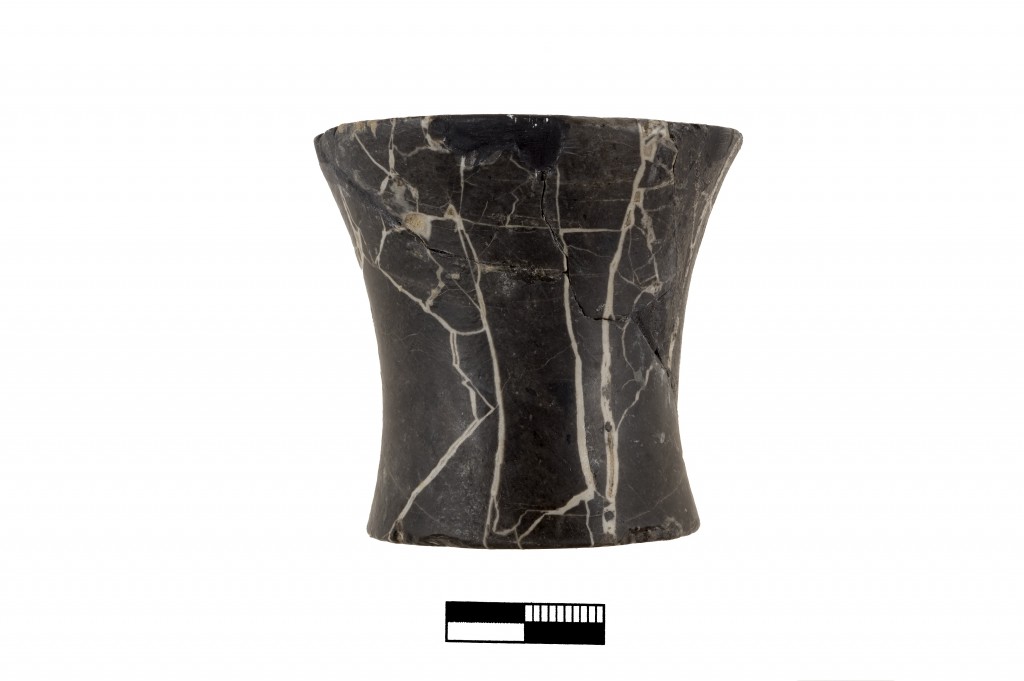
2§5 The main annex Room G provides evidence for different kinds of commemorative events that may have taken place in it, possibly until the late MM IIB phase (Schörgendorfer 1951a, 18-19; McEnroe 2010, 33). These would certainly include a very limited number of participants, as the room contained five burial containers as well: a pithos, three larnakes and a stamnoid jar. In this affective setting, toasting and drinking suggested by the presence of an undefined number of clay cups and of a limestone tumbler (HerMus L2802, Fig.6) may equally have been part of primary or secondary burials associated with the burial containers. Six other stone vessels from Room G (four ‘stone bird’s nest bowls’, cf. Figs.7a-d and two stone miniature bowls, cf. Figs.8a-b) may have been initially associated with primary interments or re-deposited here in the course of secondary depositions during commemorative rituals. Room G was also communicating directly with the forehall H/J to the complex, where an altar-like structure, now destroyed, was associated with a small stone ‘idol’ or fetish (Fig.9).[29] This vaguely recalls the female form and presents a local variant of the Early Minoan tradition of stone abstract anthropomorphic idols.[30] I can propose that it possibly helped to communicate a standardized narrative message inscribed on it upon convention. Could it have functioned as an abstraction of a female ancestor in commemorative events[31], in which only individuals entitled to enter the tomb for the inhumation or secondary burial would be able to participate?
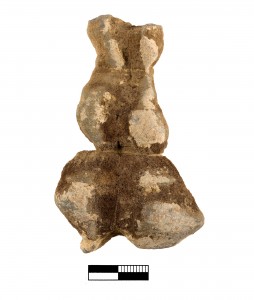
The paved area as a setting for ritual
3§1 On the other hand, collective rituals that underlined intra-group social identity were probably practiced in the open-air paved area, where a low built ‘altar’, now greatly disturbed, was also excavated.[32] This area was used for group gatherings during the mortuary events, as indicated by its assemblage which spans the EM III/MM IA to MM IIB phases, thus coinciding with all phases of use of the annex compartment.[33] Two of the seventeen miniature stone vessels deposited here date to the earliest phase of Tholos A and, thus, support the hypothesis that the use of the paved area was established at that point.[34] The assemblage of clay vessels consists of storage pots, many pouring and drinking vessels (teapots, jugs, bridge-spouted jars, and cups of all late Prepalatial to Protopalatial types), as well as shallow bowls for food consumption. The presence of large pithoid jars testifies to the use of vessels for transporting and serving liquids, most possibly wine as indicated by a clay wine-press model found in annex Room E.[35] Overall, the paved area assemblage represents the vessels used by the members of an extended family and, potentially by its relations through intermarriage as well, in several commensal events during and after the period of use of the burial chamber. It seems, though, that no large-scale feasting events were taking place here, as in the case of two ‘courtyard’ areas at Moni Odigitria[36] during the later Prepalatial period or of the Kamilari tomb during its MM III phase of use[37].
3§2 The latest object deposited at the paved area is a Middle Minoan III wheelmade pitharaki (Schörgendorfer 1951a, pl.22.2) with ritual connotations, almost identical to a smaller example from Apesokari Tholos Β (Girella 2010, 178; Girella 2013).[38] I believe that this act of deposition was connected with an important destruction event of the late Middle Minoan IIIA phase, which affected not only the centres of Phaistos, Hagia Triada and Kommos, but also the building on Vigla hill, as shown by its relevant deposits and its rebuilding.[39] The tomb may have been revisited then — and possibly reused — because of a memorial for the dead ancestors.
Conclusions
4§1 Summing up, the funeral performance would have been a communicative act involving the presence of performers entitled to enter the tomb complex and the rest of the mourners. The annex compartment functioned as a stage for group gatherings outside the tomb and also as the epicenter for formalized commemorative rituals, as revealed by the specialized patterns of the individual rooms. The best-documented stage of the sequence of mortuary rites is the post-liminal one, as inferred from the large number of drinking vessels stored in Room D. These reflect successive episodes of drinking by a selected group of people, who could enter the tomb for the secondary burials.[40] Commemoration was probably supported by objects which through their display indexed the persons to be remembered, like the abstract stone idol. Naturally, we cannot entirely decode the narratives and memories underlying some objects employed in it and possibly referencing the relationship of the living to the deceased, like the stone vessels.
4§2 The specialized patterns in the use of the annex rooms show that these were rather an integral part in the conduct of rites of a private character and not a secondary feature, as has been argued so far. The paved area provided a common focus for the attention of the assembled group that participated in the collective feasting events. It is impossible to deduce whether these took place during the primary burial depositions and/or in the framework of the post-interment rituals. In any case, the social dimension of the collective rituals taking place around the paved area should be emphasized in order to avoid a religious or secular dichotomy. While this interpretation reminds us of the Durkheimian approach to ritual as primarily serving for the reassertion of the social cohesion, recent studies have argued that the religious and profane were not so neatly separated in the Bronze Age Aegean (Darque and Van de Moortel 2009, 32).[41] At Apesokari, commensality and reciprocity played a significant role in re-establishing the bonds and common values of the living community that was affected by death. Ultimately, the end of the commemorative practices may have been caused by a disruption in the continuous chain of communicating descendants, as supported by the successive destruction horizons evidenced by the Vigla hill habitational deposits[42] from the end of the Protopalatial period onwards.[43]
Acknowledgements
This paper was written during my fellowship at the Center for Hellenic Studies of Harvard University. I warmly thank the staff, the director and the senior fellows of CHS for their hospitality and their feedback on my work and my co-fellows for the stimulating atmosphere. I am indebted to Mrs Gerlinde Schörgendorfer for her permission to study the relevant photographic and archival material that belonged to the excavator of Tholos Tomb A. I am also thankful to Sevi Triantafyllou for providing me with a preliminary report on the osteological analysis of the human remains from Apesokari Tholos Tomb A, as well as to Petros Charamis for generating the 3D model of the tomb. Funding from the Mediterranean Archaeological Trust and the Institute for Aegean Prehistory is warmly acknowledged. Figures 5-9 are reproduced courtesy of the Archaeological receipts Fund/Heraklion Archaeological Museum; drawings 5a-5b are by Giuliano Merlatti and figures 6-9 are by Chronis Papanikolopulos, INSTAP.
Bibliography
Alexiou, S. 2004. “Part I. The Tombs and the Excavations.” The Early Minoan Tombs of Lebena, Southern Crete, eds. S. Alexiou and P. Warren, 11-22. Sävedalen.
Bertemes, F., and P.F. Biehl. 2001. The Archaeology of Cult and Religion. Budapest.
Betancourt, P.P. 2012. “The Architecture of the House Tombs at Petras.” In Petras, Siteia – 25 years of excavations and studies. Acts of a two-day conference held at the Danish Institute at Athens, 9-10 October 2010, ed. M. Tsipopoulou, 107-113. Athens.
Bevan, A. 2004. “Emerging Civilized Values? The Consumption and Imitation of Egyptian Stone Vessels in EMII-MMI Crete and its Wider Eastern Mediterranean Context.” In The Emergence of Civilisation Revisited, ed. J.C. Barrett. and P. Halstead, 107-126. Oxford.
Bevan, A.H. 2007. Stone Vessels and Value in the Bronze Age Mediterranean. Cambridge.
Bintliff, J. 1977. Natural Environment and Human Settlement in Prehistoric Greece. BAR International Series 28. Oxford.
Bradley, R. 2005. Ritual and Domestic Life in Prehistoric Europe. London and New York.
Branigan, K. 1993. Dancing with Death. Life and Death in Southern Crete c. 3000-2000 BC. Amsterdam.
———. 1998. “The Nearness of You: Proximity and Distance in Early Minoan Funerary Landscapes.” Cemetery and Society in the Aegean Bronze Age, ed. K. Branigan, 13-26. Sheffield.
———. 2010. “History and Use of the Cemetery.” Moni Odigitria. A Prepalatial Cemetery and Its Environs in the Asterousia, Southern Crete, ed. A.Vasilakis and K. Branigan, Prehistory Monographs 30, 251-264. Philadelphia.
Cadogan, G. 2011. “Myrtos: From Phournou Koryphi to Pyrgos.” ΣΤΕΓΑ. The Archaeology of Houses and Households in Ancient Crete, eds. K.T. Glowacki and N. Vogeikoff-Brogan, Hesperia Supplement 44:39-50. Princeton.
Carinci, F.M. 2004. “Priests in Action: Considerazioni sulla fine dell’età prepalaziale ad Haghia Triada.” Creta Antica 5:25-41.
Cultraro, M. 2003. “La grande tholos di Haghia Triada: nuovi dati per un vecchio complesso.” Creta Antica 4:103-130.
Darcque, P., and A. Van de Moortel. “Special, Ritual, or Cultic: A Case Study from Malia.” Archaeologies of Cult. Essays on Ritual and Cult in Crete in Honor of Geraldine C. Gesell, ed. A.L. D’Agata and A. Van de Moortel, Hesperia Supplement 42:31-41. Athens.
Davaras, Κ. 1964. “Αρχαιότητες και μνημεία Κρήτης.” ADeltion, 19, Β΄3:436-447.
Dawkins, R.M., and M.L.W. Laistner. 1912-1913. “The Excavation of the Kamares Cave in Crete.” BSA 19:1-34.
Dietler, M. 2006. “Alcohol: Anthropological/Archaeological Perspectives.” Annual Review of Anthropology 35:229-249.
Flouda, G. 2011. “Reassessing the Apesokari Tholos A funerary record: preliminary thoughts.” RdA 35:111-121.
———. 2012. “A Travelogue to Crete 1941-1943: The Photo-archive of the Austrian Archaeologist August Schörgendorfer.” Proceedings of the Symposium “Days of 1943. Εveryday life in Οccupied Crete”, 26 & 27 November 2012, Historical Museum of Crete, 59-63. Heraklion.
Fowler, C. 2013. “Identities in Transformation: Identities, Funerary Rites, and the Mortuary Process.” In The Oxford Handbook of Death and Burial, eds. L. Nilsson Stutz and S.Tarlow, 511-526. Oxford.
Girella, L. 2008. “Feasts in ‘Transition’? An Overview of Feasting Practices during MM III in Crete.” DAIS. The Aegean Feast. Proceedings of the 12th International Aegean Conference/University of Melbourne, Centre for Classics 25-29 March 2008, ed. L.A. Hitchcock, R. Laffineur, and J. Crowley, AEGAUM 29:167-178. Liège and Austin.
———. 2010. Depositi ceramici del Medio Minoico III da Festòs e Haghia Triada. Padova.
———. 2013. “Further Notes on the So-called Minoan ‘Egyptianizing Amphorae: New Evidence from Kamilari.” In Φιλική Συναυλία. Studies in Mediterranean Archaeology for Mario Benzi, ed. G. Graziadio, R. Guglielmino, V. Lenuzza, and S. Vitale, BAR International Series 2460, 15-29. Oxford.
Hamilakis, Y. 1998. “Eating the Dead: Mortuary Feasting and the Politics of Memory in the Aegean Bronze Age.” Cemetery and Society in the Aegean Bronze Age, ed. K. Branigan, 115-132. Sheffield.
———. 2013. Archaeology and the Senses. Human Experience, Memory, and Affect. Cambridge.
Hertz, R. 1960. Death and The Right Hand. Trans. Rodney and Claudia Needham. London.
Kimball, S.T. 1960. “Introduction.” The Rites of Passage, A. Van Gennep, i -xix. Chicago.
Kopaka, K., and L. Platon. 1993. “Ληνοί μινωικοί. Installations minoennes de traitement des produits liquids.” BCH 117 (1):35-101.
Legarra Herrero, B. 2012. “The Construction, Deconstruction and Non-construction of Hierarchies in the Funerary Record of Prepalatial Crete.” In Back to the Beginning. Reassessing Social and Political Complexity on Crete during the Early and Middle Bronze Age, ed. I. Schoep, P. Tomkins, and J. Driessen, 325-357. Oxford and Oakville.
———. 2014. Mortuary Behavior and Social Trajectories in Pre- and Protopalatial Crete. Prehistory Monographs 44. Philadelphia.
Levi, D. 1961-1962, La tomba a tholos di Kamilari presso a Festòs. ASAtene, 39-40:7-148.
McAnany, P. 2000. Living with the Ancestors: Kinship and Kingship in Ancient Maya Society. Austin.
McEnroe, J.C. 2010. Architecture of Minoan Crete: Constructing Identity in the Aegean Bronze Age. Austin.
Michelaki, F., T. Campbell-Green, and K. Branigan. 2011. “Pottery usage in the Prepalatial cemetery at Moni Odigitria.” 10th International Cretological Congress, Khania 2006. Vol. A2. Proistorikoi chronoi, ed. M. Andreadaki-Vlazaki and E. Papadopoulou, 571-582. Khania.
Miller Bonney, E. 2009. “A Reconsideration of Depositional Practices in Early Bronze Age Crete.” Aegean Archaeology 8 [2005-2006]:31-50.
Mills, B.J., and W.H.Walker. 2008. “Introduction: Memory, Materiality, and Depositional Practice.” In Memory Work. Archaeologies of Material Practices, ed. B.J. Mills and W.H.Walker, Santa Fe.
Murphy, J. 1998. “Ideologies, Rites and Rituals: A View of Prepalatial Minoan Tholoi.” Cemetery and Society in the Aegean Bronze Age, ed. K. Branigan, 27-40. Sheffield.
Murphy, J.M. 2003. Changing roles and locations of religious practices in South-Central Crete during the Pre-palatial and Proto-palatial periods. PhD diss., University of Cincinnati.
———. 2011. “Landscape and Social Narratives: A Study of Regional Social Structures in Prepalatial Crete.” Prehistoric Crete. Regional and Diachronic Studies on Mortuary Systems, ed. J.M.A. Murphy, 23-47. Philadelphia.
Papadatos, Y. 2005. Tholos Tomb Gamma: A Prepalatial Tholos Tomb at Phourni, Archanes. Prehistory Monographs 17. Philadelphia.
Papadatos, Y., and C. Sofianou. 2009-2010. “A Prepalatial Tholos Tomb at Mesorrachi Skopi, near Siteia, East Crete.” AEA 10:7-31.
Papadatos, Y. 2014. “Proanaktorika nekrotafeia tholoton tafon sti voreia kai anatoliki Kriti.” In Spyridon Marinatos, 1901-1974. His life and times, ed. E. Mantzourani and N. Marinatos, 205-222. Athens.
Pendlebury, J.D.S., M.B. Money-Coutts, and E. Eccles. 1932-1933. “Journeys in Crete, 1934.” BSA 33:80-100.
Sakellarakis, Y., and E. Sapouna-Sakellarakis. 1997. Archanes. Minoan Crete in a New Light. Athens.
Sapouna-Sakellaraki, E. 1983. “To eidolio tou Sampa kai ta amorpha lithina eidolia tes Proïmes Epoches tou Chalkou sten Krete.” AE 1983:44-74.
Schörgendorfer, A. 1951a. “Ein mittelminoisches Tholosgrab bei Apesokari.” In Forschungen auf Kreta 1942, ed. F.Matz, 13-22. Berlin.
———. 1951b. “Die minoische Siedlung von Apesokari. Vorläufiger Grabungsbericht.” In Forschungen auf Kreta 1942, ed. F. Matz, 23-26. Berlin.
Shelmerdine, C.W. 2008. “Background, Sources, and Methods.” In The Cambridge Companion to the Aegean Bronze Age, ed. C.W.Shelmerdine, 1-18. Cambridge.
Tomkins, P., and I. Schoep. 2010. “Crete.” In The Oxford Handbook of the Bronze Age Aegean, ed. E. Cline, 66-82. New York.
Tomlinson, B. 2009. “A Proximate Mechanism for Communities of Agents to Commemorate Long Dead Ancestors.” Journal of Artificial Societies and Social Simulation 12(1)7 <http://jasss.soc.surrey.ac.uk/12/1/7.html>.
Triantafyllou, S. forthcoming. “Managing with death in Prepalatial Crete: the evidence of the human remains.” In From the Foundations to the Legacy of Minoan Society, eds. M. Relaki. and Y Papadatos.
Tsipopoulou, M. 2012. “The Prepalatial-Early Protopalatial Cemetery at Petras, Siteia: a Diachronic Symbol of Social Coherence.” In Petras, Siteia – 25 Years of Excavations and Studies. Acts of a two-day conference held at the Danish Institute at Athens, 9-10 October 2010, ed. M. Tsipopoulou, 117-129.
Van de Moortel, A. 2011. “The Phaistos Palace and the Kamares Cave: A Special Relationship.” In Our Cups Are Full: Pottery and Society in the Aegean Bronze Age: Papers Presented to Jeremy B. Rutter on the occasion of his 65th birthday, ed. W. Gauß, M. Lindblom, R.A.K. Smith, and J.C. Wright, 306-318.
Van Gennep, A. 1960. The Rites of Passage. Chicago.
Vavouranakis, G. 2012. “O tholotos tafos B sti thesi Apesokari Mesaras.” In Proceedings of the 2nd Scientific Meeting for the Archaeological Work in Crete, 26-28 November 2010, ed. M. Andrianakis, P. Varthalitou, and I. Tzachili, 144-153. Rethymno.
———. forthcoming. “Ο ΠΜ-ΜΜ θολωτός τάφος Β στο Απεσωκάρι Μεσαράς: Τα αποτελέσματα των εργασιών των ετών 2012 και 2013.” Proceedings of the 3d Scientific Meeting for the Archaeological Work in Crete, 2013.
Warren, P.M. 1969. Minoan Stone Vases. Cambridge.
[1] The relative and absolute chronology dates follow the relevant table on Shelmerdine 2008, fig. I.I.
[2] Henceforward, these chronological phases will be mentioned as EM and MM.
[3] In a few cases, tholos tombs continued to be used in the Neopalatial period. Although circular tholos tombs used over long periods of time predominate in south-central Crete (Branigan 1993, 13-15), new excavations in east Crete at Mesorrachi Skopi (Papadatos and Sofianou 2009-2010) and Livari (Papadatos 2014, 207, 215-218, figs.1, 7) suggest that they were not a regionally specific phenomenon.
[4] The need to exploit the dispersed small stretches of land and the few water resources explains the marked density of small settlements and the corresponding tholos tombs in the mountainous Asterousia region, cf. McEnroe 2010, 26. Bintliff (1977, 633-637) has suggested that especially in the case of Hagiopharango valley the construction of a burial structure contributed to bond a particular kin group with the land it exploited.
[5] This notion touches upon one of the key questions in the study of the Mesara during the Early and Middle Minoan period, namely how to differentiate community groups on the basis of the material remains, since Mesara tholos tombs have rarely been published together with their associated settlements. For a comprehensive summary of past studies and of the relevant interpretive problems, see Legarra Herrero 2014, 35-36.
[6] The name Vigla in Greek means “the look out post”.
[7] Schörgendorfer, who served on Crete as a lieutenant attached to the ‘Art Protection’ unit of the Wehrmacht (Flouda 2011, 111; Flouda 2012), probably chose to excavate the tomb and the settlement after reading John Pendlebury’s report stating that he, Edith Eccles and Mercy Money-Coutts visited the site, where the latest interments of a tholos tomb had been messed up from the villagers, and mentioning the traces of the settlement (Pendlebury et al. 1932/1933, 88). Although the excavator published two brief excavation reports in 1951, the material remains from the tomb were presented selectively, while those from the settlement were not studied at all.
[8] It arguably follows a trend established already in the Early Minoan period at the sites of Lebena, Koumasa and, perhaps, even Hagia Kyriaki (Branigan 1998, 19; Miller Bonney 2009, 42).
[9] Henceforward, “EM” will abbreviate “Early Minoan” and “MM” will stand for “Middle Minoan”.
[10] This hypothesis is justified by the EM III/MM IA cups which were stacked in the annex Room D next to the entrance of the burial chamber.
[11] The burial containers that were recently restored confirm that individualized burial was also practiced, see Flouda 2011, 116. The deceased buried in them were most probably temporarily individuated, since there is evidence from several tombs that bones were periodically removed from burial containers and collected into pits outside the tombs (Hamilakis 2013, 156; Vavouranakis, forthcoming).
[12] Branigan 1993, 57-58 discusses many cases of floors laid under and between the burial strata in the Mesara tholos tombs.
[13] Since Schörgendorfer (1951a, 15) notes that the burials were in a flexed/contracted position, we can infer that the preserved human remains represent the latest more or less disarticulated depositions as well as fragmented bones preserved from the earlier interments.
[14] This applies to almost all Prepalatial and Protopalatial burials studied so far; Alexiou (2004, 16) notes that in the Lebena Yerokambos II tomb “the intermixing of materials in the tomb was probably caused both by the manner of the original placing of the bodies on top of each other and the subsequent moving of remains to create space for later burials”. Even in the case of Archanes Tholos C which was not looted, it was established that the finds deposited at the floor of the tomb could not be related with any skeletal remains from the lower burial stratum or with burials in the larnakes of the upper burial stratum (Papadatos 2005).
[15] The small ‘bird’s nest bowl’ is in its size, internal dimensions and stone-choice typical of those found predominately in the Mesara and of EM III-MM I date. The lidded jar finds its closest parallel in the early example L1154 from the cemetery at Pseira in east Crete, cf. Warren 1969, 24.
[16] For a parallel practice at Moni Odigitria, see Michelaki, Campbell-Green and Branigan 2011, 572. Pouring libations is another possible, but not evident, form of ritual taking place in the burial chamber.
[17] Decomposed earlier depositions from the burial chambers of the tholos tombs were usually moved to the annex rooms to make room for new interments, see Triantafyllou, forthcoming.
[18] The three inhumations recovered in rooms C and E show that the annex rooms could serve as repositories for the decomposition of the bodies before specific parts were selected to be stored elsewhere, and, occasionally, for primary inhumation see Flouda 2011, 116.
[19] The retention of skulls is also known from other Mesara tombs and from the Myrtos Pyrgos Ossuary 1 in east Crete, see Cadogan 2011, 46.
[20] The results of the osteological analysis undertaken by Sevi Triantafyllou will be published in a forthcoming study. The sample comprises one child aged 6 to 12 years, one infant aged 1 to 6 years and twelve adults. Six male and four female individuals have been recognized, while two adults are of indeterminate sex. The relatedness of those individuals according to cranial and post-cranial non-metric traits has not been determined.
[21] It is also plausible that the social agents directly involved in the burial events eventually found out about the decomposition of the deceased as need for the next interment arose.
[22] Van Gennep 1960, 146; Hertz 1960, 44.
[23] This becomes obvious if we keep in mind that in many cases the skeletons were also dissociated from their burial containers, see Murphy 2011, 39.
[24] These date to the earliest phase of use of the Tholos A annex (EM III late to MM I A phases).
[25] A fragmentary conical bowl, similar to the one deposited in Room E as a burial gift (Schörgendorfer 1951a, 17, pl.22.4) is reported by Schörgendorfer as recovered from Room D. This type probably served for holding food offerings, the presence of which has been inferred by Alexiou (2004, 16) on the basis of evidence from the Lebena Yerokambos II tholos tomb.
[26] Carinci 2004, 27.
[27] Alexiou 2004, 19.
[28] Vavouranakis 2012, 146-147.
[29] It was formed by a 65 cm long limestone slab which has not been preserved in situ.
[30] Sakelllarakis and Sapouna-Sakellarakis 1997, 507. It is nevertheless differentiated from the highly standardised pebble- or plank-shaped figurines from Early to Middle Minoan contexts (Sapouna-Sakellaraki 1983, 72, pl.A΄).
[31] Bertemes and Biehl (2001, 17) have approached anthropomorphic figurines of the 5th millennium BC from southeast Europe along similar lines.
[32] We can postulate that the low outer wall on the north side of the annex compartment served as an external bench for placing offerings. An analogy may be provided by similar benches excavated all around House Tomb 2 at Petras/Siteia, Betancourt 2012, 109; Tsipopoulou 2012, 121, fig.3.
[33] It was excavated at the south and west side of the paved area of Tholos A, see Schörgendorfer 1951a, 20-22. Most of the sherds can be dated only on the basis of other published parallels cited by the excavator, as it is impossible to identify them among the Apesokari pottery boxes without provenance labels. The ones described are comparable to the contemporary domestic pottery assemblages from Vigla hill.
[34] The ‘bird’s nest bowls’ L2816-2817 (cf. Schörgendorfer 1951a, pl. 23.5, 24.2) may be the earliest offerings of the paved area, as they belong to a group of the late Prepalatial and early Protopalatial period (EM III – MM I, “hatch-and-inlay group”), see Bevan 2007, 91.
[35] Flouda 2011, pl. XXXVIII,c. Four similar models excavated in the neighboring Tholos B also testify to the wine producing tradition of the region, see Kopaka and Platon 1993, 41 fig.4.
[36] At Moni Odigitria high quantities of cooking vessels, many large bowls (diam. 40+ cm) and smaller numbers of outsized jugs, dishes and jars were concentrated in two of the ‘courtyard’ areas, see Branigan 2010, 258-260.
[37] A few complete and fragmentary cooking pots were deposited during the MM III and LM I periods in both the main chamber, the annexes, and the external courtyard of the Kamilari Tholos A, see Girella 2008, 174, pl. XXXd.
[38] Other parallels come from well-dated contexts of the early Neopalatial period (MM IIIA) at Kamilari, Hagia Triada and in the area outside Tholos A at Vorou.
[39] After a rebuilding phase, habitation in the building continued for sure until up to the late Neopalatial period ; there are only hints of habitation in the Early Final Palatial period (particularly the LM II-III A1 phases).
[40] This reconstruction reminds us of similar rituals documented by the deposit in annex L of Tholos A at Ayia Triada, see Cultraro 2003.
[41] See also Bradley 2005, 120 who argues that “in prehistory ritual gave domestic life its force, and domestic life in turn provided a frame of reference for public events”.
[42] This hypothesis draws on findings by a relevant simulation (computational model) generated by Tomlinson (2009, §3.16, §4.2).
[43] Alternatively we may face another case of “the absence of the burial in the archaeological record”.

